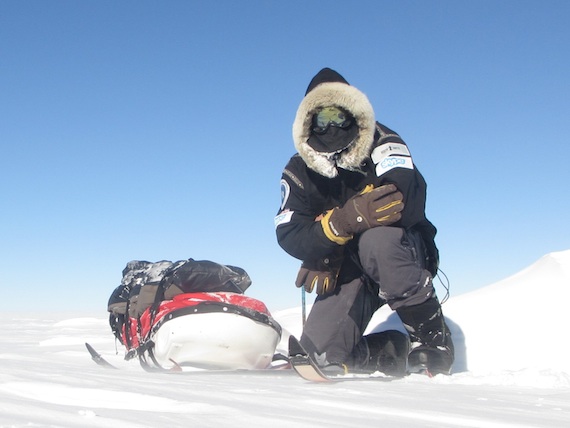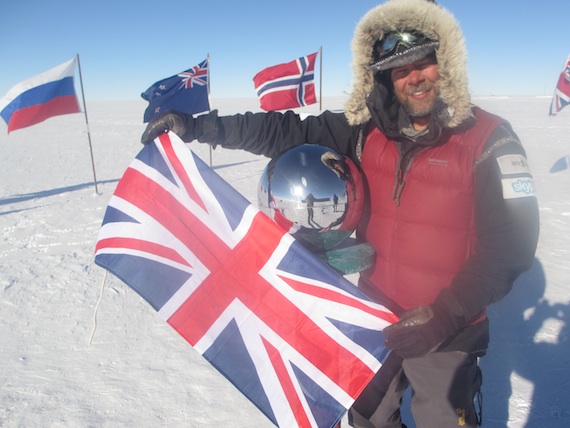Videoconferencing | Feature
Skyping from the Frozen Wilds to the Classroom
World explorer Mark Wood uses Web-based videoconferencing technology to educate and interact with schoolchildren.
- By Bridget McCrea
- 04/03/13
You would think that polar explorer Mark Wood would have enough on his plate just trying to become one of eight individuals ever to reach the South Pole unassisted, but this explorer frequently takes the time to use technology to interact with schoolchildren worldwide. Using a laptop, Webcam, and a Skype connection, Wood reaches into K-12 classrooms to share his knowledge, experiences, and environment with students who wouldn't otherwise have direct access to intrepid explorers.
Wood, who is currently exploring Mt. Everest and Skyping his experiences, wrapped up a solo expedition to both the North and South Poles last spring. He did some legwork before departing on his trip by arranging numerous Web-based calls with schools worldwide. Teachers would book 15 to 20 minute time slots with Wood, who used Skype every day to attend those online meetings and share his experiences with youngsters. "For the final stage of my trip," he said, "I'm going to try to visit all of those schools to meet the students and teachers in person."
Over the last few years, Wood said, he's used the technology to communicate "from the mountains and ice to thousands of students in 40 different countries." For 12 years Wood has been completing expeditions, dog sledding, and working in mountain rescue service roles. As a former educator, Wood always found ways to share his experiences with youngsters.


Mark Wood on his North South Solo Expedition last spring |
While working in the Himalayas with a group of teachers, for example, Wood shared his remote explorations using a Skype connection and donated/sponsored electricity and Internet access. "We put up screens and projectors, showed the teachers how to use them, and then linked the equipment with UK schools," said Wood. The teachers would speak to the class for about 15 minutes and then answer student questions. Students and teachers then retreated to "regular" class time for about 45 minutes of debate and discussion about the presentation.
Wood has also used Skype to connect with schools in the US. Recently, for example, a teacher in Chicago took an interest in the explorer's blogs and Twitter contributions. The teacher contacted Wood and invited him to participate in a videoconference with students. Working from the Arctic at the time, Wood set up a monitor and Webcam in a room that had an impressive view of the outside world. The teacher did the same in his classroom — only with a projection screen instead — and the pair scheduled time for the Skype call.
"I was preparing for a North Pole expedition and students got an up-close view of my surroundings on the projection screen," said Wood. "They wanted to know everything about what I was doing, where I was going, and the environment that I was working in. The interaction was as inspiring for me as it was for them."
Those awe-inspiring moments aren't always easy to capture when Wood is out in the wild. "When we get into remote areas the clock goes back about 25 years technology-wise," said Wood, who frequently serves as the technology "champion" when collaborating with other explorers and with the locals in the regions where he's working. "I've gone up a mountain for a few weeks and had people pack up all of my videoconferencing equipment in boxes because they didn't know how to use it."
To help educate others on the value of connecting with other countries, cities, and people online, Wood has set up Internet cafés in remote villages and then used the revenues generated to support local schools. He has also helped create Web-based communication links between Himalayan villages that take two to three days to reach by foot. "This ongoing effort started out as a way to connect schools," said Wood, "and has since expanded to include village-to-village communications for people who live in mountainous areas."
Wood said establishing real-time video links from the field and into schools around the world is a huge improvement over traditional methods used by explorers. "Years ago it would take months and months for explorers to get back home and tell their stories," said Wood. "Nowadays you can tell the story in the moment and let students actually 'see' the world around you — instead of just 'telling' them about it."
That benefit stream runs flows ways, according to Wood, who recently found himself without an iPod just two days into his last 60-day Arctic journey. "I had nothing to stimulate my brain for a 60-day period," he said, "it was horrendous." Knowing that students were tracking his progress and being able to stay in touch via the Web-based videoconferencing, helped Wood maintain his sanity through the arduous trip. "Being able to contact the students en route and knowing that they were tracking me," he said, "inspired me and led me on."
Mark Wood's current adventurs in the wild are documented on his site. Images, stories, and information about participating in live streams can be found at markwoodexplorer.com.
About the Author
Bridget McCrea is a business and technology writer in Clearwater, FL. She can be reached at [email protected].